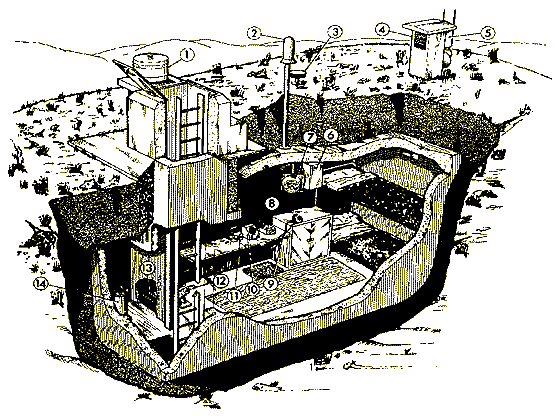Nynehead R.O.C. (Royal Observer Corps) Post.
In the days when gentlemen wore long trousers to play lawn tennis and ladies did not, it was pretty clear who the enemy was and how to "frustrate their knavish tricks." After the 1914-18 War it became apparent that one of the likeliest knavish tricks would be that he ('she' being then unheard of) would fly a machine over and drop something from a great height that might or might not explode on impact below. In 1925 it was therefore deemed prudent to create a body whose task was identifying enemy aircraft. That body was the Royal Observer Corps (ROC).
As ever better methods of killing one another were devised, culminating in the ability to 'deliver' nuclear weapons, the ROC was assigned the added responsibility, and latterly sole task, of reporting nuclear explosions and monitoring fall-out. To assist them, work began in the mid-1950s on constructing 1563 underground monitoring posts throughout the UK, one of which was in Nynehead.
Posts were clustered in 3's and 4's for triangulation - a way of fixing a geographical location from a number of bearings. A local command post relayed information received from each sub-post to Sector Operations Centres where scientists would 'interpret' the data i.e. reassure the public that we had nothing to worry about while advising the people who mattered, the politicians etc, where to go for safety. To give fall-out protection, it was decided new 'monitoring rooms' would be constructed underground, usually at the same location as the aircraft spotting posts that, for obvious reasons, were usually in relatively elevated positions. That in Nynehead, at 73 metres, sits atop 'The Knapp' [probably from cnæp, Anglo-Saxon for 'top, cop, knop or button'] from where there are fine views northwards to the Quantox and Brendon Hills and southwards to the Blackdown Hills.
A typical post [see sketch below] consisted of a 15ft entrance shaft giving access to two rooms; one contained a chemical loo, vital, I imagine, in the event of a close nuclear explosion; the other, larger (typically 15ft X 7ft) monitoring room had basic furniture plus the monitoring and communications equipment. A ventilation shaft with two louvred vents was located alongside the entrance shaft with a second air shaft at the other end of the room - particularly useful bearing in mind the proximity of the chemical loo. Lighting was from a 12-volt battery. With few exceptions this layout was the same at all locations although the monitoring equipment was 'refined' during the late '50s.

[1] Ground zero indicator. [2] Fixed survey meter probe cover. [3] Bomb power indicator baffle plates.
[4] Air ventilator. [5] Pneumatic Antenna Mast for Radio set. [6] Radio set. [7] Bomb power indicator.
[8] Fixed survey meter. [9] Radio head set. [10] Loud speaker telephone. [11] Carrier reciever.
[12] Pump for pneumatic antenna. [13] 12 volt battery. [14] Lavatory.
Radiation was measured in roentgens per hour from a surface mounted ionisation chamber that could be withdrawn below the surface yet continue to operate. Its data were transmitted down a pipe to the chamber below. A Bomb Power Indicator capable of measuring pressures of up to 51b/sq in, also fed information from the surface to the chamber below. Last was the Ground Zero indicator (GZI). This consisted basically of a four-in-one pinhole camera whose four holes faced the cardinal compass points. In the event of a nuclear burst, the image of the fireball would be projected through one or more of the pinholes and recorded on photographic paper. From this information the bearing and elevation of the burst could be calculated. The GZI was mounted on a convex metal plate, usually located on top of the vent shaft next to the entrance. It required someone to emerge into the open to retrieve the sheets of photographic paper!
In January 1968, the then Labour Government decided the threat of a nuclear attack had lessened and as part of massive reductions in defence spending the strength of the ROC was halved, from 25,000 to 12,500 resulting in the closure of more than half the underground posts. A final restructuring took place during the 1980's.
Regular training continued through the 70's and 80's but in 1991 it was decided by the Home Office & MOD that the ROC would cease active training presumably on the assumption by the great and the good that the threat of nuclear fall out was either negligible or, more sinister, no longer of concern to our masters and might even been deemed a blessing in disguise as a means of winnowing the 'swinish multitude'. Either way, the remaining underground posts were closed at the end of September 1991. Some reverted back to the original landowners, others were put out to public tender, many of the latter being snapped up by cellphone operators because of their strategic positions on high ground.
The Nynehead R.O.C. Post is at approx. ST 1620 2335 on private land adjacent to a public highway.
